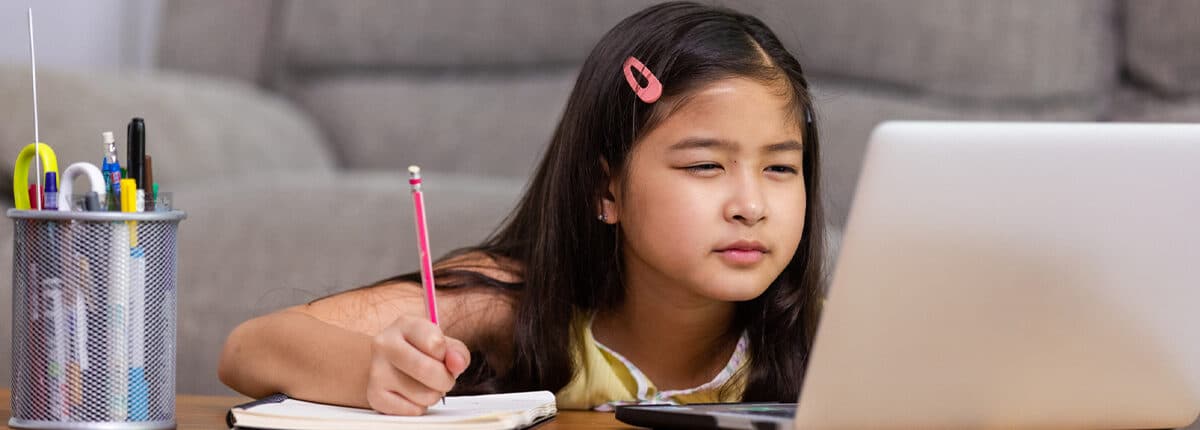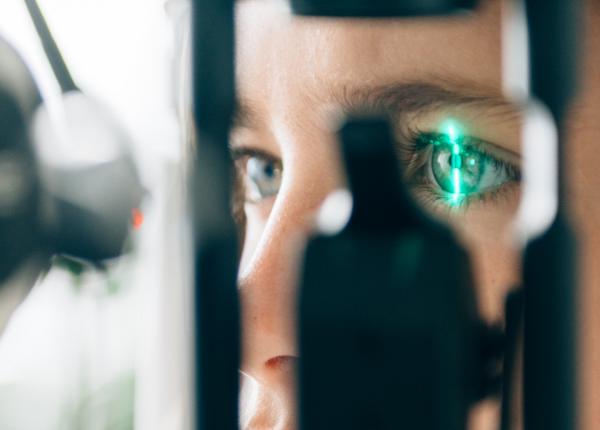
Myopia in Children: Testing and Treatment Recommendations for Parents
19 MAR 2024
Children's eye health
Myopia, otherwise known as nearsightedness or shortsightedness, can impact a child’s eye health and their ability to clearly see distant objects. This condition—where distant objects appear blurry, while close objects remain in focus—can significantly impact a child’s learning and development. Early detection and management of myopia are therefore fundamental in ensuring that your child maintains good eye health so they can continue doing all the things they enjoy—including playing with friends, learning at school, and all their other fun activities.
There are a few signs to look out for if you believe your child has myopia. There are also a number of strategies you can implement to prevent and mitigate myopia from developing, including booking an appointment with your local optometrist. For more information on myopia, how you can spot it, and how you can help your child if you believe they are developing myopia, continue reading.
What is myopia?
Myopia is an eye condition characterised by blurry vision when looking at distant objects. This condition occurs when light rays entering the eye do not focus directly on the retina but instead fall in front of it. Essentially, this is due to the elongation of the eyeball or changes in the natural lens of the eye, affecting the way light rays are refracted within the eye. With a better understanding of myopia, what causes it and how it can be treated in children, you can begin to seek treatment for your child so they can see the world around them more clearly.
Types of myopia
There are two types of myopia: refractive myopia and axial myopia. These classifications are each based on different underlying causes of the condition:
- Refractive myopia occurs when the cornea and the natural lens inside the eye have too much focusing power compared to the length of the eye. This imbalance causes light rays to converge before they reach the retina, resulting in blurry distance vision.
- Axial myopia, on the other hand, is caused by the elongation of the eyeball itself. In this type of myopia, the eye grows longer than normal from front to back, causing light rays to focus in front of the retina rather than directly on its surface. This type of myopia is more closely associated with progressive myopia, where the elongation can continue over time, potentially leading to high myopia.
Beyond these two classifications of myopia, there are other types of myopia that fall within these categories:
- Simple myopia: This is the most common type of myopia. It is often caused due to a minor refractive error and can be easily corrected with glasses or contact lenses.
- High myopia: This severe form of myopia increases the risk of eye health complications, such as retinal detachment. It often requires more specialised intervention to manage effectively, beyond glasses or contact lenses.
- Degenerative myopia: Also known as pathological or progressive myopia, this rarer form of myopia worsens over time, potentially leading to vision loss. It’s important to monitor closely due to its association with various eye health issues.
- Induced myopia: Certain environmental factors can result in or exacerbate myopia, such as diabetes. Induced myopia may fluctuate over time, and in some cases can be reversed.
What causes myopia in children?
The development of myopia in children can be attributed to both genetic and environmental factors.
If one or both of a child’s parents have myopia, then the child is at a higher risk of also developing myopia. Environmental factors that can also affect myopia, such as spending excessive time reading, using smartphones or tablets, or spending little time outdoors, have been shown to contribute to increasing rates of myopia in children.
Understanding these risk factors is crucial for parents and caregivers to take preventive measures and seek early intervention for their children’s eye health.
Genetics
Family history can play a big part in child myopia. Children with one or both parents who are myopic have a higher chance of developing myopia themselves.
Prevention: While you can’t change your child’s genes or what traits you pass down to them, regular eye exams can help detect myopia early on. This allows for a timely intervention.
Limited outdoor activity
Spending little time outside has been linked to an increased risk of children developing myopia. This is because natural light and focusing on distant objects outdoors can affect eye development for children.
Prevention: Encourage children to spend more time outside each day to support healthy eye development. Of course, it’s also important to make sure you’re taking factors such as sun safety into account.
Excessive near work
Activities that require focusing on close objects for prolonged periods, like reading, and using smartphones or tablets, can strain the eyes and may contribute to myopia progression. Close work can increase the demand on the eye’s focusing system, potentially leading to the elongation of the eyeball, which is a characteristic of myopia.
Prevention: It can be tough to get your child off their smart device. But ensuring that your child takes regular breaks during near work to take the strain off their eyes can help to prevent myopia.
Poor lighting
Insufficient lighting requires the eyes to work harder to focus, causing the eyes to strain. Playing on a smart device or reading in poorly lit conditions can cause eye strain and may contribute to the development of myopia in children.
Prevention: When your child is reading or doing their homework, make sure they have plenty of lighting to help reduce eye strain. This could be from a natural light source or from a lamp or room light that gives them plenty of visibility.
Signs and symptoms of myopia
Myopia in children can manifest through several observable signs. Recognising these symptoms early is vital for prompt intervention, ensuring that measures can be taken to support the child’s eye health.
These are just three common signs and symptoms that your child may have myopia.
Squinting
When children squint, they are trying to minimise the amount of light entering their eyes, which can temporarily improve their focus on distant objects. Squinting is a common sign of myopia and indicates that the child is struggling to see clearly. Parents might notice their child squinting when trying to focus on the television, the blackboard in school, or when attempting to identify distant objects during outdoor activities.
Frequent headaches
Regular headaches can often accompany myopia in children. These headaches typically result from the strain of trying to focus on images that appear blurry. The eye strain puts continuous pressure on the eyes, leading to discomfort around the forehead and temples. If your child frequently complains of headaches, especially after reading, watching TV, or spending time on the computer, it might be time to schedule an eye examination with your local Eyecare Plus optometrist.
Difficulty seeing distant objects clearly
A clear indicator of myopia is when a child has trouble seeing distant objects. They may struggle to read signs or see details from far away that others with normal vision can see easily. As a parent, you may notice that your child is having difficulty paying attention to distant details or needs to sit closer to the television to see clearly.
Myopia treatment and management options for children
Myopia can significantly impact a child’s eye health and quality of life if it’s not addressed soon enough. In certain severe cases, such as high myopia, there’s an increased risk of retinal detachment, glaucoma and macular degeneration—all of which can potentially cause blindness in middle age. This is why it’s so important to monitor your child for signs of myopia and intervene if you notice some telltale symptoms.
If your child does develop myopia, then there are a number of ways you can help mitigate its progression and still ensure your child is not missing out on any of the essential parts of their childhood by using specially designed spectacle lenses, contact lenses and eye drops.
Glasses and contact lenses
For children diagnosed with myopia, contact lenses and glasses are the primary methods for vision correction. Depending on your child’s age, they may feel more comfortable with a pair of glasses or contact lenses. At Eyecare Plus, we have a wide range of different styles of glasses to choose from, so your child is sure to find a pair they love. We also have different types of contact lenses available, including daily contact lenses and monthly contact lenses.
Lifestyle adjustments
Incorporating lifestyle adjustments, such as increasing outdoor activities and taking regular breaks from close work, can play a significant role in managing myopia. These simple changes are recommended to help slow the progression of myopia, offering an easy and non-invasive approach.
Monitoring symptoms and seeking professional care
Regular eye examinations are crucial for monitoring the progression of myopia and adapting treatment plans as needed. At Eyecare Plus, we recommend that children have their first eye test at the age of one. Then, it’s recommended for them to be tested again at ages three and five. It’s important to make sure your child has their eyes tested before they start school so they can get the most out of their education.
With regular eye tests from a trusted professional, you can effectively monitor your child’s eye health and ensure they’re not showing any signs of myopia. And if they do begin to show symptoms, there are many ways you can begin to address these issues. Consulting with a trained Eyecare Plus eye specialist is a great place to begin, as they can advise you on the most suitable treatments for your child.
Find your nearest optometrist today and book an appointment with Eyecare Plus.
Book an appointment with
your local Eyecare Plus
Optometrist today.

